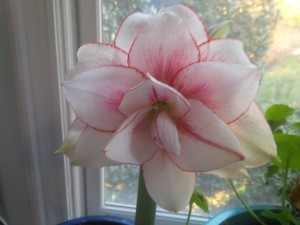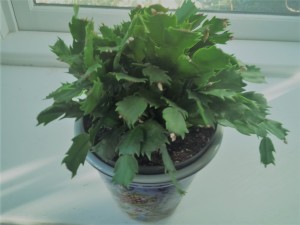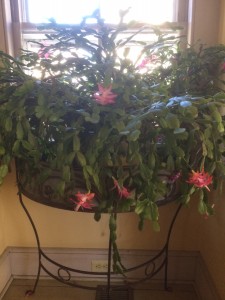 I love giving plants at holiday time. It fits with my horticultural sensibility. Most people appreciate a blooming plant, especially one that will continue to add color and/or interest after the holiday baubles go back in their boxes. But with plants as with all gifts, it is important to match the gift to the recipient. Your sister may welcome the biggest, reddest poinsettia on the block, while your neighbor may think such a thing is tacky or worry that her omnivorous dog will chew the leaves and take ill. Before bestowing a green gift, use the same kind of “right plant, right place” thinking you use when choosing a garden location for a new plant acquisition.
I love giving plants at holiday time. It fits with my horticultural sensibility. Most people appreciate a blooming plant, especially one that will continue to add color and/or interest after the holiday baubles go back in their boxes. But with plants as with all gifts, it is important to match the gift to the recipient. Your sister may welcome the biggest, reddest poinsettia on the block, while your neighbor may think such a thing is tacky or worry that her omnivorous dog will chew the leaves and take ill. Before bestowing a green gift, use the same kind of “right plant, right place” thinking you use when choosing a garden location for a new plant acquisition.
For Avid Gardeners
People who like to grow plants outside are generally good at keeping them alive inside as well. These individuals are perfect recipients for holiday plants that can be made to rebloom, or a least thrive long after the holidays are over.
Amaryllis or hippeastrum, especially top-quality specimens, fit in this category. They bloom magnificently, sometimes producing three or four flower stalks from one giant bulb. After the flowers die back, the plants sprout long, strappy green leaves. If you keep watering and fertilizing when the top of the soil is dry, this will continue right through the summer.
A good gardener will decide whether he or she wants to go through the rather precise steps required to make the amaryllis bloom at holiday time next year. If he or she is a little more laissez faire, the individual may opt to treat the amaryllis like any other houseplant and wait for the plant to rebloom on its own schedule. No matter which path your amaryllis recipient chooses, he or she will enjoy the plant for a good long time.
If you are buying amaryllis for a plant enthusiast, avoid waxed bulbs. The wax coating seals the bulb, thereby providing a great one-time experience that must inevitably be followed by a trip to the compost pile.
Holiday or “Christmas” cacti–Schlumbergera bridgesii–are also wonderful, long-lived plants that feature orchid-like blooms in shades ranging from white through pinks, peaches, reds and red-oranges. I have a friend who nurtured a small, average-size specimen into a behemoth over the course of a number of years. When not in bloom, Christmas cacti are rather crab-like in appearance, with flat, segmented leaves that arch outward. They are ridiculously easy to care for as long as you don’t overwater, and appreciate a summer vacation outdoors every year if you can manage it. Like amaryllis, Christmas cacti can be persuaded to rebloom on a specific schedule, but will also rebloom when their internal clocks tell them the time is right.
For Everyone Else
If you don’t know whether a particular recipient is a plant lover, choose a one-off gift that will look good during the holidays and leave the scene thereafter. Poinsettias, or Euphorbia pulcherrima, are perfect for this. The array of flower forms and colors increases every year, with classic red plants blooming on garden center pallets alongside specimens that appear to have been tie-dyed. I especially like the rose-form types with curled petal rows.
If you water your poinsettias when the top of the soil feels dry and keep them out of direct sunlight, the petals—which are really a type of leaves called “bracts”—will last for a good long time. Technically speaking, you can take the time and trouble to cosset a poinsettia into rebloom, but most people, even avid gardeners, regard that as a waste of time. Poinsettias are relatively inexpensive and easily replaceable. If you are giving them as gifts, be mindful of households with children and pets. Ingesting plant parts can sometimes cause digestive problems and the milky sap in the stems may irritate skin.
Florists’ cyclamen, or Cyclamen persicum, are everywhere at this time of the year, sporting gorgeous marbled leaves and butterfly-like blossoms in pinks, purples, reds and whites. I love them, but keeping them going takes more fortitude than many people have. Under normal indoor conditions, the plants start to fade after the blooms drop. Leaves depart the scene in an alarming way, making the average person afraid—and guilty—about “killing the plant”. At this point, or sometimes before, they throw the cyclamen away. In fact, patience and knowledge of the plant’s habits—including the habit of leafless dormancy—will enable the dedicated plant lover to bring about another season of growth and bloom. However, most people do not have patience and knowledge of the plant’s habits. Give cyclamen to those individuals as a glorious one-off, knowing that you can always purchase another one, possibly in a new and different color, next year.
Of course, when you give any holiday present, you relinquish control of that item. Give an Hermes scarf and you hope the individual will wear it joyfully, but she may decide to regift it, store it in the attic, or donate it to a thrift shop. You have to hope for the best, but admit the reality. It is like that with plants too. Do your best to match the plant with the individual and then let go. The energy you save can be better spent coaxing your own cyclamen into rebloom.
